The Oxford Companion to Italian Food begins the entry on garlic with a truth. This liliaceous plant with its pungent bulb has played quite “an ambivalent role in Italian gastronomy.”[1] Perhaps that’s to be expected from something that, says Wikipedia, propagates asexually and produces hermaphrodite flowers! Propagation aside, garlic’s ambivalence is its magic. As any cook knows, it has a remarkable capacity to assume, as stated in The Oxford Companion, “many personalities – raw and crude, it has an aggressive bite which disappears when lightly cooked in oil, or simmered in stews, when it becomes sweet and mild. Crushed with salt… it gives pungency to sauces…, it can be mild and nutty when pickled,” and it is lively in a salad! But that’s only a part of the magic.
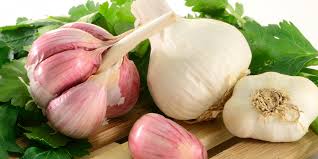
The “many personalities” garlic assumes in kitchen pots and on dining tables is more than matched by a long and often ambivalent history in which it is celebrated for its curative powers and condemned as injurious, the source for all sorts of ills.
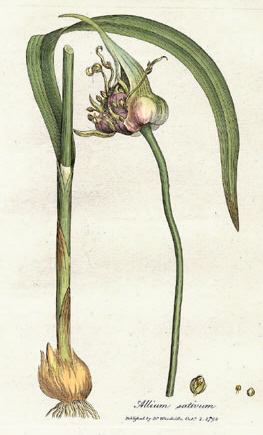
The magic – and magical potency – of garlic was recognized, it seems, from the moment of its emergence into European culture. In his encyclopedic Natural History (XIX. 101), Pliny the Elder (died 79 CE) noted that “whenever they take an oath, the Egyptians swear by garlic and onions as though they were gods.” Why garlic and onions were granted this honor rather than, say, saffron, is not disclosed. In any event, the ancient Egyptians seem to have held garlic in high repute, for it made its way into Tutankhamen’s tomb. Garlic, fit for a pharaoh, was also valued as a food especially appropriate for galley slaves, soldiers, and those performing heavy labor.[2] It was a marvel. In fact, Pliny devotes an entire chapter (book 29, chapter 34) to garlic. Among it’s more amazing feats is the job it does in crop fields, protecting newly sown seeds “from the remorseless ravages of the birds.” All you need to do is boil the garlic and scatter it about. Birds will be become “stupefied” by it and drop to the ground like a stone… but only momentarily so. Industrious farmers will have just enough time to gather and remove these dazed birds before they come round! Could this ability to ward off threats have inspired Bram Stoker to choose garlic as an effective vampire-repellant in Dracula, 1897? Perhaps. It certainly seems to speak to a belief in its ability to keep the unwanted away. Between a top-floor apartment I once rented in Rome and the ground floor was an obstacle of an impressive pile of garlic and onions. The old woman who created this smelly mélange believed it kept the black cats that roamed the neighborhood away from her door! I think it did. I never saw a cat within a block of the building!
But back to garlic’s medicinal history.
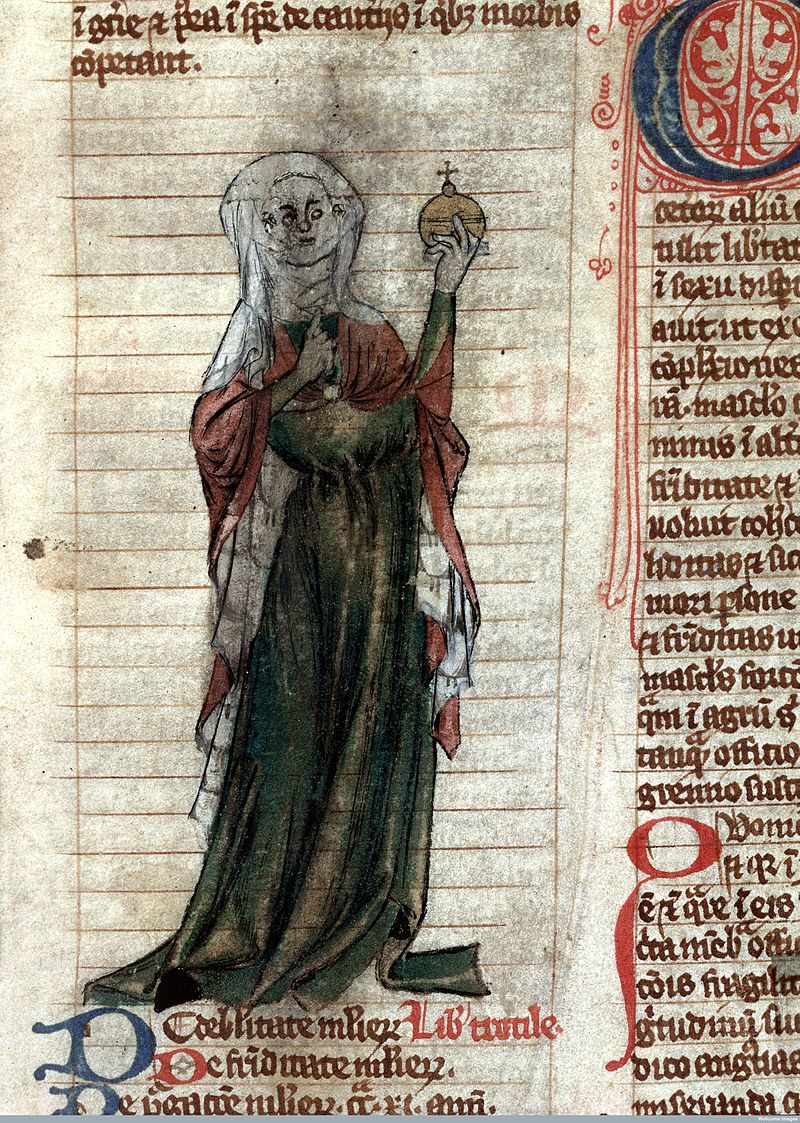
Garlic made it into the most renowned medieval texts devoted to women’s health. It is referenced in the Physica of Hildegard of Bingen, who was Abbess of Rupertsberg, (1098-1179) and the Trotula, a 12th century collection of three books. The latter reflects the practices advocated by a group of physicians in southern Italy who knew the practices advocated in classical texts and were also fluent with the progressive ideas of Arabic medicine. Hildegard recommended eating garlic raw but in moderation “lest a person’s blood becomes too hot.”[3] Trotula, described as a “wise woman from Salerno” in a letter dated 1059, includes garlic in list of “hot” foods that can help women suffering from a “paucity of menses.” And, again because of its heat, she considers it bad for wet nurses. A variation on the theme of garlic’s heat and consequential benefits is found in a passing remark by the Sephardic Jewish scholar Maimonides (1135-1204). In deciding which ordinances of Abraham Ibn Ezra to include in the Mishnah, he opted to omit one cited in the Babylonia Talmud (BT 82a). Although eating garlic on Sabbath eve had been a “custom” because it “aided” the production of semen, he apparently felt it necessary to prescribe the practice.[4]
More generally, Trotula prescribed garlic as a component in a recipe for benedicta, “so-called because of all the things from which it is comprised [including wild garlic], it is blessed.” In this concoction of spikenard, roses, ginger, saffron, poppy, pepper, and other things, garlic is something of a miracle ingredient, good against gout and for problems with the kidneys.[5]
These uses continued in the centuries to come as still others were added. In the 16th century, Pietro Mattioli of Siena prescribed garlic for digestive disorders and, interestingly, as helpful to women enduring difficulty in childbirth. In Dyets Dry Dinner (London, 1599) Henry Buttes acknowledged “Garlicke” to be “of most special use for Sea-faring men: a most excellent preservative against infection proceeding from the nasty savor of pump or sinck, and of tainted meates which Mariners are faine to eate for fault of better.”[6] Baldassare Pisanelli had made a similar observation three years earlier in Trattato della natura de’ cibi e del bere (Rome, 1583).
But what was prescribed for sailors was proscribed for landlubbers suffering from gout, or so suggested Christophorus Ballista in his poem “The Overthrow of the Gout,” which is known only through a 1577 edition in the British Library. The relevant passage reads as follows:
“All Salt and slimy meats, and flesh
that long doth powdered lye,
And fish in Salt preserved: all such
I warn thee to flee.
Both Garlick, Rue and Onions sour
expel them far from thee,
Although the fond Egyptians do
suppose them Gods to be.”[7]
The list of health benefits derived from garlic has continued to grow. According to a study published in the British Medical Journal on August 17, 1991, it has positive effects on “coagulation, platelet aggregation, and serum lipid concentrations.”
But garlic has not always been the magical cure all. Attitudes have been ambivalent. The Summoner in Geoffrey Chaucer’s (1343-1400) Canterbury Tales makes the point.
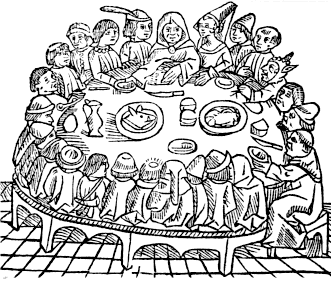
Described in the book’s “General Prologue” as physically repulsive and morally reprehensible, the red-faced, heavy-lidded, and pustule-covered Summoner is a lover of “garleek,” onions, leeks, and red wine. At least one commentator has linked the Summoner’s appearance and tastes to the Bible, specifically Numbers 11:5.[8] It is here that the Hebrews complain about having only manna to eat and lament the absence of cucumbers, leeks, onions, and garlic from their diet. Since the time of St. Gregory (circa 540-604), commentators have read the Old Testament passage allegorically. Our experience of the world, including its delights, cause us to cry. The Liber de Mortalitatibus was less poetic and far more harsh. Garlic was equated with the stench of evil, blamed for ulcerating the body, said to weaken the vision, and disparaged for the general frenzy it caused. No wonder Samuel Johnson defined a “Garlickeater” as “a mean fellow”!
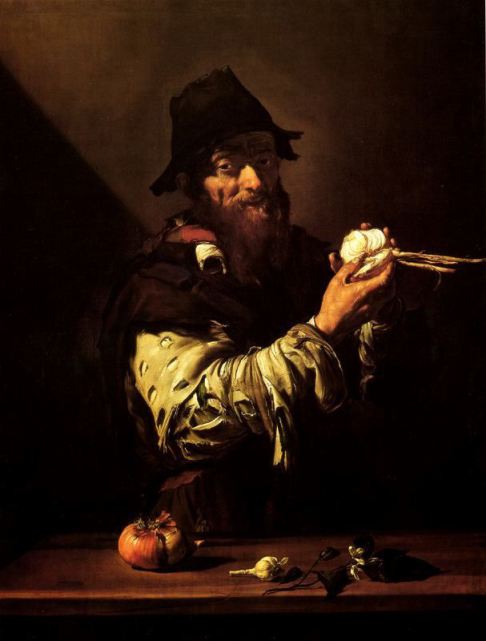
And so to the end… although Shakespeare in A midsummer night’s dream (act iv, scene iii) has ‘Bottom’ advise his acting troupe to “eat no onions or garlic, for we are to utter sweet breath” and thus be applauded for a sweet comedy, I say bring it on and to this delectable end I give you an Epicurious recipe for garlic soup.
http://www.epicurious.com/recipes/food/views/roasted-garlic-soup-with-parmesan-cheese-100669
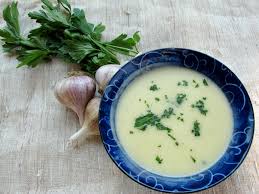
ROASTED GARLIC SOUP
Ingredients:
- 26 garlic cloves (unpeeled)
- 2 tablespoons olive oil
- 2 tablespoons (1/4 stick) butter
- 2 1/4 cups sliced onions
- 1 1/2 teaspoons chopped fresh thyme
- 18 garlic cloves, peeled
- 3 1/2 cups chicken stock or canned low-salt chicken broth
- 1/2 cup whipping cream
- 1/2 cup finely grated Parmesan cheese (about 2 ounces)
- 4 lemon wedges
- Preheat oven to 350°F. Place 26 garlic cloves in small glass baking dish. Add 2 tablespoons olive oil and sprinkle with salt and pepper; toss to coat. Cover baking dish tightly with foil and bake until garlic is golden brown and tender, about 45 minutes. Cool. Squeeze garlic between fingertips to release cloves. Transfer cloves to small bowl.
- Melt butter in heavy large saucepan over medium-high heat. Add onions and thyme and cook until onions are translucent, about 6 minutes. Add roasted garlic and 18 raw garlic cloves and cook 3 minutes. Add chicken stock; cover and simmer until garlic is very tender, about 20 minutes. Working in batches, purée soup in blender until smooth. Return soup to saucepan; add cream and bring to simmer. Season with salt and pepper. (Can be prepared 1 day ahead. Cover and refrigerate. Rewarm over medium heat, stirring occasionally.)
- Divide grated cheese among 4 bowls and ladle soup over. Squeeze juice of 1 lemon wedge into each bowl and serve.
** In the spirit of Renaissance cuisine, I add the following just because!!
In The Art and Craft of a Master Cook, 1570, Bartolomeo Scappi, who many consider to be the most renown Italian chef of the period, used garlic in his recipe for braising a suckling calf’s head (“with its hair off and the head clean”) cleaved in half! First parboil the garlic then add it to the following: cinnamon, pepper, cloves, saffron, diced prosciutto, and muscatel raisins. Braise! Scappi also added garlic to a recipe for fricassee of a breast of suckling veal, crushing it with sweet fennel, salt, pepper, cloves, and cinnamon. As for the eminent Maestro Martino of Como, in Libro de Arte Coquinaria (The Art of Cooking), ca. 1465, he advises its “generous” use in the roasting of kid.
Go for it!
[1] Gillian Riley, The Oxford Companion to Italian Food (OPxford: Oxford University Press, 2007), pages 226-27.
[2] Patrick Faas, Around the Roman Table. Food and Feasting in Ancient Rome (Chicago: University of Chicago Press, 1994), page 216. This might be related to its medicinal value. Of the 800 herbal remedies in the Codex Ebers, an Egyptian medical papyrus of around 1550 BCE, twenty-two contain garlic.
[3] Hildegard von Bingen’s PHYSICA, The Complete English Translation of her Classic Work on Health and Healing, trans. Priscilla Throop (Rochester, VT: Healing Arts Press, 1998), page 45 (chapter LXXIX is devoted to Garlic). If garlic causes stomach pain, she suggests parsley as an antidote.
[4] The reference to the ordinance is in Maimonides, Commentary on the Mishna, Nedarim 8:4. See, Maimonides, Herbert Davidson, Moses Maimonides: The Man and His Work (Oxford: Oxford University Press, 2004), page 224, note 152.
[5] The Trotula: An English Translation of the Medieval Compendium of Women’s Medicine, trans. Monica H. Green (Philadelphia: University of Pennsylvania Press 2001), page 126.
[6] Ken Albala, Eating Right in the Renaissance (Berkeley: University of California Press, 2002), page 203.
[7] Robert M. Schuler, ed., “Three Renaissance Scientific Poems,” Studies in Philology, vol. 75 (1978), page 90. The lines quoted are 267-270. I have altered the spelling in the original text to make it more accessible. Christophorus Ballista is the Latinized name of Christophe Arbaleste, a French monk and physician who left the Catholic Church at the beginning of the Reformation and went to live in Strasbourg. There, he became acquainted with Martin Bucer and other religious reformers. He is known to have treated the Bishop of Sion for gout.
[8] Robert Earl Kaske, Medieval Christian Literary Imagery (Toronto: University of Toronto Press, 1989); Stephen Henry Rigby, Chaucer in Context: Society, Allegory and Gender (Manchester: Manchester University Press, 1997), page 87ff for a discussion of Canterbury Tales, I. 634.
